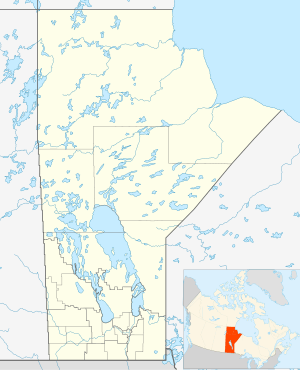Birdtail Sioux First Nation facts for kids
| People | Dakota |
|---|---|
| Headquarters | Beulah, Manitoba |
| Land | |
| Main reserve | Birdtail Sioux |
| Land area | 28.85 km2 |
| Government | |
| Chief | Ken Chalmers |
| Tribal Council | |
| Dakota Ojibway Tribal Council | |
The Birdtail Sioux First Nation, also known as Chankagha Otinta, means 'People of the Log Houses'. This Dakota First Nation community is located about 50 kilometers north of Virden, Manitoba. Around 643 people live on their land, which covers about 7,128 acres (28.85 square kilometers).
Their land is next to the Rural Municipality of Miniota and the Rural Municipality of Ellice – Archie. The main community area of Birdtail Sioux is found at 50°16′N 101°09′W.
The Birdtail Sioux First Nation has important services for its members. They have a school for all grades, from kindergarten to grade 12. This school is called Chan Kagha Otina Dakota Wayawa Tipi School. There is also an adult learning centre, which helps adults continue their education. Both schools are run by the Frontier School Division. The community also has its own police station, the Manitoba First Nations Police. This police service used to be known as the Dakota Ojibway Police Service. A health center is also available to help keep everyone healthy.
Contents
Working Together for the Community
The Birdtail Sioux First Nation has made some important partnerships. These partnerships have sometimes caused discussions among different Dakota communities. Under the leadership of Chief Ken Chalmers, Birdtail Sioux worked with the Canadian government and private companies.
Building Projects and Partnerships
These partnerships helped build new projects on the reserve. For example, they built a new health center and a shopping center. They also worked on a project to renovate 62 homes. Companies like Enbridge and Canadian National Railway were part of these agreements.
Different Views on Community Progress
Some other Dakota First Nations had concerns about these partnerships. They worried that Birdtail Sioux's focus on "short-term gains" might affect bigger Dakota land claims. These claims go back to 1870. A land claim is when a group says they have rights to land based on their history.
The Canadian government's view has been that the Dakota people are refugees from the United States. Because of this, the government has argued that the Dakota do not have the same aboriginal rights in Canada. This means they might not get land, money, or official recognition as Canadian Indigenous people. The government has said the Dakota live in Manitoba because the Crown (the Canadian government) allows them to.
However, the Dakota people, except for Birdtail Sioux, wanted to use old maps and documents. These papers were from before Canada became a country. They hoped to negotiate a new, modern treaty based on these historical claims. A treaty is a formal agreement between nations.
Chief Chalmers' Approach
Chief Chalmers explained his reasons for partnering with others. He said, "The only way I can get things like the renovations going... I can only get it by partnering, not fighting." He believed working together was the best way to improve life on the reserve.
Chief Frank Brown of the Canupawakpa Dakota First Nation had a different opinion. He felt that the government sometimes tries to "divide and conquer." This means giving money to one group to make them agree, while other groups are still fighting for their rights. He said, "The job creation is a good thing, but it's not fixing nothing, it's just a little Band-Aid." He believed that while jobs are good, they don't solve the bigger issues. He felt that working for the future of all Dakota people was more important.
Leadership Changes and Elections
In March 2013, the Birdtail Sioux community voted for a new chief. Chief Chalmers was not re-elected, and former Chief Kelly Bunn won. However, in March 2015, Ken Chalmers was elected chief again.
In March 2017, the Birdtail Sioux First Nation adopted a new law called the First Nations Election Act. This law allowed them to choose if their Chief and Council would serve for two or four years. Chief Chalmers was re-elected again and served until March 2021.


